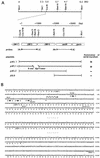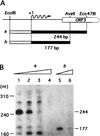Characterization of an A-factor-responsive repressor for amfR essential for onset of aerial mycelium formation in Streptomyces griseus
- PMID: 9748440
- PMCID: PMC107543
- DOI: 10.1128/JB.180.19.5085-5093.1998
Characterization of an A-factor-responsive repressor for amfR essential for onset of aerial mycelium formation in Streptomyces griseus
Abstract
A-factor (2-isocapryloyl-3R-hydroxymethyl-gamma-butyrolactone) is essential for the initiation of aerial mycelium formation in Streptomyces griseus. amfR is one of the genes which, when cloned on a low-copy-number plasmid, suppresses the aerial mycelium-negative phenotype of an A-factor-deficient mutant of S. griseus. Disruption of the chromosomal amfR gene resulted in complete abolition of aerial mycelium formation, indicating that amfR is essential for the onset of morphogenesis. Cloning and nucleotide sequencing of the region upstream of amfR predicted an operon consisting of orf5, orf4, and amfR. Consistent with this idea, Northern blotting and S1 mapping analyses suggested that these three genes were cotranscribed mainly by a promoter (PORF5) in front of orf5. Furthermore, PORF5 was active only in the presence of A-factor, indicating that it is A-factor dependent. Gel mobility shift assays showed the presence of a protein (AdpB) able to bind PORF5 in the cell extract from an A-factor-deficient mutant but not from the wild-type strain. AdpB was purified to homogeneity and found to bind specifically to the region from -72 to -44 bp with respect to the transcriptional start point. Runoff transcriptional analysis of PORF5 with purified AdpB and an RNA polymerase complex isolated from vegetative mycelium showed that AdpB repressed the transcription in a concentration-dependent manner. It is thus apparent that AmfR as a switch for aerial mycelium formation and AdpB as a repressor for amfR are members in the A-factor regulatory cascade, leading to morphogenesis.
Figures







Similar articles
-
amfR, an essential gene for aerial mycelium formation, is a member of the AdpA regulon in the A-factor regulatory cascade in Streptomyces griseus.Mol Microbiol. 2003 Nov;50(4):1173-87. doi: 10.1046/j.1365-2958.2003.03760.x. Mol Microbiol. 2003. PMID: 14622407
-
Cloning of the conserved regulatory operon by its aerial mycelium-inducing activity in an amfR mutant of Streptomyces griseus.Gene. 2003 Mar 13;306:79-89. doi: 10.1016/s0378-1119(03)00405-0. Gene. 2003. PMID: 12657469
-
Cloning and characterization of a gene involved in aerial mycelium formation in Streptomyces griseus.J Bacteriol. 1995 Nov;177(22):6401-10. doi: 10.1128/jb.177.22.6401-6410.1995. J Bacteriol. 1995. PMID: 7592414 Free PMC article.
-
The A-factor regulatory cascade and cAMP in the regulation of physiological and morphological development in Streptomyces griseus.J Ind Microbiol Biotechnol. 2001 Sep;27(3):177-82. doi: 10.1038/sj.jim.7000068. J Ind Microbiol Biotechnol. 2001. PMID: 11780789 Review.
-
A microbial hormone, A-factor, as a master switch for morphological differentiation and secondary metabolism in Streptomyces griseus.Front Biosci. 2002 Oct 1;7:d2045-57. doi: 10.2741/A897. Front Biosci. 2002. PMID: 12165483 Review.
Cited by
-
Developmental regulation of the Streptomyces lividans ram genes: involvement of RamR in regulation of the ramCSAB operon.J Bacteriol. 2002 Aug;184(16):4420-9. doi: 10.1128/JB.184.16.4420-4429.2002. J Bacteriol. 2002. PMID: 12142412 Free PMC article.
-
Hormonal control by A-factor of morphological development and secondary metabolism in Streptomyces.Proc Jpn Acad Ser B Phys Biol Sci. 2007 Dec;83(9-10):277-95. doi: 10.2183/pjab/83.277. Proc Jpn Acad Ser B Phys Biol Sci. 2007. PMID: 24367152 Free PMC article. Review.
-
AmfS, an extracellular peptidic morphogen in Streptomyces griseus.J Bacteriol. 2002 Mar;184(5):1488-92. doi: 10.1128/JB.184.5.1488-1492.2002. J Bacteriol. 2002. PMID: 11844785 Free PMC article.
-
Taxonomy, Physiology, and Natural Products of Actinobacteria.Microbiol Mol Biol Rev. 2015 Nov 25;80(1):1-43. doi: 10.1128/MMBR.00019-15. Print 2016 Mar. Microbiol Mol Biol Rev. 2015. PMID: 26609051 Free PMC article. Review.
-
Whole lifecycle observation of single-spore germinated Streptomyces using a nanogap-stabilized microfluidic chip.mLife. 2022 Sep 24;1(3):341-349. doi: 10.1002/mlf2.12039. eCollection 2022 Sep. mLife. 2022. PMID: 38818224 Free PMC article.
References
-
- Babcock M J, Kendrick K E. Transcriptional and translational features of a sporulation gene of Streptomyces griseus. Gene. 1990;95:57–63. - PubMed
-
- Beck E, Ludwig G, Auerswald E A, Reiss B, Schaller H. Nucleotide sequence and exact localisation of the neomycin phosphotransferase gene from transposon Tn5. Gene. 1982;19:327–336. - PubMed
-
- Bibb M J, Findlay P R, Johnson M W. The relationship between base composition and codon usage in bacterial genes and its use for the simple and reliable identification of protein-coding sequences. Gene. 1984;30:157–166. - PubMed
-
- Chater K F. Morphological and physiological differentiation in Streptomyces. In: Losick R, Shapiro L, editors. Microbial development. Cold Spring Harbor, N.Y: Cold Spring Harbor Laboratory; 1984. pp. 89–115.
Publication types
MeSH terms
Substances
Associated data
- Actions
LinkOut - more resources
Full Text Sources

